This article first appeared on February 2001 issue of the Horological Journal.
It is available in pdf format for off-line reading and printing.
Click on this link to download the compressed file (251 KB)
Renato and Franco Zamberlan discuss recent work on St Mark's Clock in Venice.
On 18th October 1996, the Director of Venetian Museums, Giandomenico Romanelli, and the General Manager of Piaget International, Francis Gouten, signed an agreement for the restoration of the St. Mark's Clock in Venice. The Clock was indeed running, but needed a general overhaul. The project was to be sponsored by PIAGET, which, according to newspaper accounts contributed around £150,000 for the restoration.
Romanelli chose a historian, Giuseppe Brusa, to accomplish the task. Brusa selected Alberto Gorla, a blacksmith specialising in tower clocks, to carry out the work. Oddly enough, the Venetian authorities gave no other clockmakers or historians an opportunity to tender. This is the first time this has happened in the 500 year history of the Clock. Mr. Romanelli said that Giuseppe Brusa was suggested by the British Museum, but Brusa has recently denied this. The reason for the choice is still not clear.
A Restoration Committee was formed. During an official press briefing held in Palazzo Ducale on 24th January 1997, Mr Mossetto, who is responsible for cultural activities of the Venetian Municipality, said that the committee included Giuseppe Brusa as the director, Alberto Peratoner (the last "temperatore", the custodian of the clock) and Alberto Gorla; chosen by the Venetian Municipality, and Gabriel Piaget and Francis Gouten; chosen by PIAGET.
Although Peratoner, who has the most direct long- term knowledge of the clock, was nominally involved in the Committee, he was effectively left out of this group. Most recently he was not included in the Restoration Committee as described in official press announcements by PIAGET and the Venetian Municipality. These listed the committee as Giuseppe Brusa, Alberto Gorla, Gabriel Piaget, Yves Piaget, Giandomenico Romanelli (Director of Venetian Museums) and Daniela Andreozzi (Venetian Museum Architect). The Venetian authorities and Piaget have never explained the reason for the exclusion of Alberto Peratoner.
It is clearly documented that the restoration was to be conservative. As is common practice in modern restoration work, no additions or modifications to the movement were permitted other than the provision of an automatic winding mechanism. In a 1988 interview, published by the Italian magazine "Orologi", Romanelli described the temperatore as a "difficult to replace cultural and human heritage", but the introduction of automatic winding would eliminate the role.
Recently, Brusa suggested that Alberto Peratoner has started a campaign against the restoration work because of the loss of his personal involvement with the clock (the temperatore lived and worked inside the Clock Tower, earning a wage for this).
The Clock
As we wrote in our previous article, the current mechanism dates back to 1757-1759. It was heavily modified in 1858- 1860, mainly with the addition of a digital time indication system. The Graham deadbeat escapement was replaced with a pinwheel and the pendulum was lengthened from a 1828bph to a 1800bph, a neat 2 seconds.
From that time to present, the clock was simply overhauled. Only minor repairs were carried out. All of its features worked, except for the 132-blow strike, which was deactivated during World War I for the curfew. Brusa has suggested that it stopped working due to the 1858 restoration, but elderly Venetians, alive during WWI, can remember that it was stopped for the curfew.
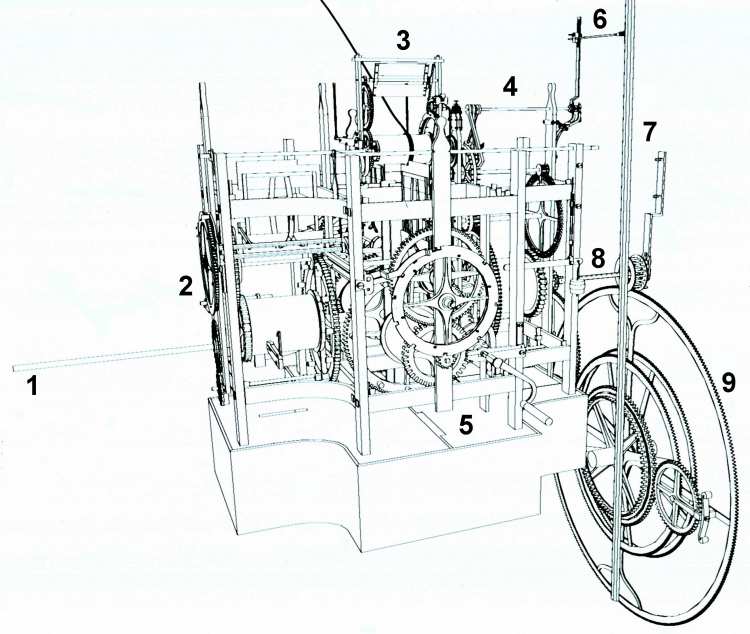
Drawing 1.
The movement prior to the recent restoration, as it appears from a drawing made by Piaget.
In our view two points are clear:
The Restoration
Brusa decided that the 1858 interventions made by Luigi De Lucia were detrimental to the wonderful 1757 mechanism made by Bartolomeo Ferracina. He determined that the original 1757 situation had to be restored, even if this meant the replacement of some 1858 parts with newly made ones. In his opinion the clock was in such bad condition that it couldn't run any more without carrying out these substitutions; only the 1757 movement features could guarantee reliable operations.
As we'll see further on in this article, this is difficult to sustain. Almost all the changes made don't improve the performance of the clock. Nobody expects an antique clock to run like a quartz, but everybody wants it in a nearly untouched state. Instead of trying to return to an imperfectly known 1757 state, the 1858 modifications should have been preserved. The 1858 mechanism had given 140 years of uninterrupted operation.
The Changes Made
Here is how Brusa and Gorla carried out the restoration. They cleaned and polished all the parts, installed new bushings, burnished pivots, replaced fly-springs, etc... but many other interventions were also made.
The clock after the recent restoration. Click to enlarge.
Pendulum Length
They replaced the 2-second pendulum (1800 bph) made in 1858 (13.05ft. long, with an octagonal wooden rod and a polished lenticular brass bob engraved; "Luigi De Lucia", with a new one, 2828 bph (6.2ft. long iron rod; cast iron bob punched: "Alberto Gorla 1998"). We think this is wrong not only from the conservation point of view, but also from the historical point of view.
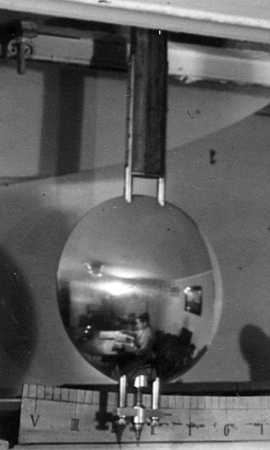
The 1858 bob, signed by Luigi De Lucia, mirrors the scene in the room below the clock.
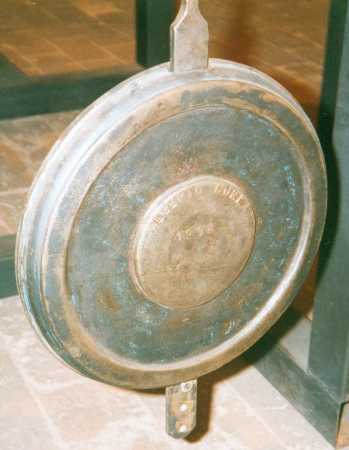
The new bob. Not very elegant, in our opinion.
The reader will be asking how Brusa could know the exact beat rate of the 1757 pendulum. Well, there is a book describing the clock as it was in the 18th Century: "Relazione storico-critica delta Torre dell'Orologio di S. Marco in Venezia" by Nicolo Erizzo. It is clearly stated that the pendulum made 1828bph. Brusa believes that this a typographical error and that it means 2828bph. He says that it is not logical that when De Lucia altered the escapement in 1858 he would have altered the pendulum rod by only a few inches (1828bph to 1800bph). The work required to modify the train would not have been justified by such a slight modification. He concludes that it must have been changed to accommodate a much longer rod. The logic of this is not clear especially because the new pendulum by Brusa and Gorla actually makes 2600bph, and not 2828 as we could expect if the typographical error was true. Where does the 2600 value come from?
The escapement was changed from deadbeat to pinwheel, the escape wheel had to be remade so any desired rod could have been accommodated. It seems more likely, as the literature clearly indicates, that the clock already had a long pendulum which was simply modified to a more convenient beat.
There is another historical source to confirm how wrong this choice has been. As described in our previous article, the 1858, 2-second pendulum extended through a hole in the floor of the clock room; the 6.2ft. pendulum that Brusa says was fitted in 1757, being much shorter, would not. Such, a hole should work in 1857. Sebastiano Cadel has written, for the Venetian Municipality, a detailed account of the work done on the building at that time. There is absolutely no mention in this document of the need to make a hole in the floor. This suggests that the hole in the floor existed since Ferracina's time and is another confirmation that Ferracina's pendulum must have been about 13ft long.
Pendulum Position
Brusa and Gorla moved the pendulum suspension point from the time train side of the movement to the 132-blow strike train side. That is to say to the opposite side of the structure. This required an elongated arbor to bring the motion from the anchor to the crutch, now very far from the escapement.
The reason the restorers gave for making this change is the presence of four aligned holes on the clock frame where the arbor may pass through. Brusa and Gorla say that their presence is enough to show that in 1757 the pendulum was mounted on the opposite side of the time train. This may be so, but every clockmaker finds unused holes in antique clocks and without further supporting evidence it is not enough to start making new parts to fit them.
To accommodate the new long arbor required lifting the 5-minute mechanism, (3, on drawing, 1). A steel structure was made for this purpose and we must say that it doesn't follow any antique style at all. It makes use of modern square tubing anyone can find at a local metal store. The main frame of the movement is made of beautifully forged iron. Brusa and Gorla repeatedly affirmed that: "The methods and materials used for restoration are the same stated by the most antique tradition in iron tower clocks".
Suspension Spring
The new suspension is of the leaf-spring type, while the 1858 one was a knife edge. Brusa and Gorla make no reference to the reason why they changed it and there is no source, to our knowledge, where it can be found that the 1757 suspension was spring-type, even if the principle of conservative restoration is disregarded.
Suspension Attachment
The new point where the suspension is attached is exactly in the middle of the clock. Prior to the recent restoration it was placed to one side. The rod was connected to the escapement by a horizontal link (6, in drawing 1) as is common on Comtoise clocks. This avoids interference with the transmission arbor (8, in drawing 1), which carries the motion to the dial and protrudes from the middle of the movement.
Gorla placed the new pendulum on the other side of the mechanism but here too the secondary dial arbor protrudes from the middle. He solved this problem by fabricating a sort of 'open-frame' rod, through which the arbor can pass.
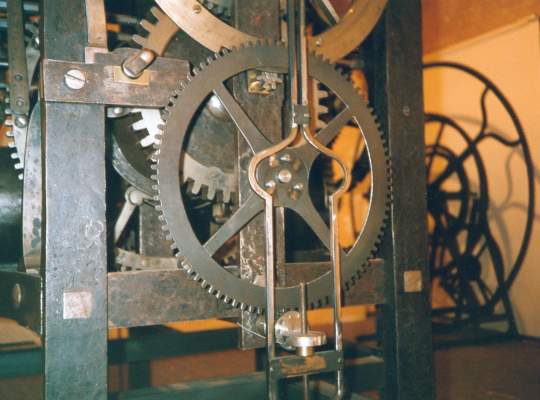
In this photo the secondary dial arbor is not present, but it will be fixed to the three metric pitch steel screws seen on the black finish wheel hub. Note the roughly plugged holes.
It is hard to imagine that a great clockmaker like Ferracina could conceive such a complicated solution when he made the clock. There is no historical record of a pendulum like this, of course, but once again Brusa and Gorla, facing a doubtful situation, decided not to leave thing as they were, as in conservative restoration, but to change them even if they didn't exactly know how.
A drawing taken from a technical brief by Annibale Marini (clock technician) and Giovanni Doria (temperatore) written for the Venetian Municipality on 22nd July 1856, before De Lucia's work, indicates that this is an illogical construction. This "Relazione" describes the clock and the works required for its repair. A sketch shows the horizontal link to the pendulum, and the text says that "improvements to this part are needed, to enable the temperatore dismantling and cleaning it, being the actual part fixed". Brusa says this must be simply a proposal, because in the drawing the arm is facing left instead of right. We cannot however be sure of the viewpoint of the artist.
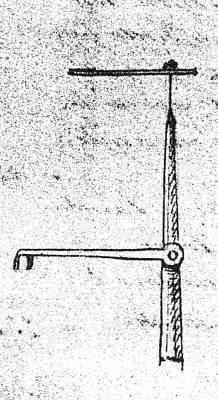
The sketch by A. Marini and G. Doria showing the horizontal link to the pendulum predating the 1858 movement.
Is it possible that a 1757 pendulum had metric regulating screws or square cold rolled steel for its structure, as found in Gorla's reproduction?
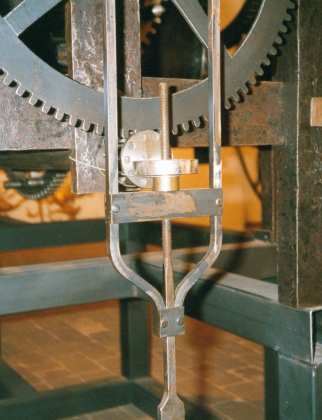
Detail of the time regulating screw on the new pendulum.
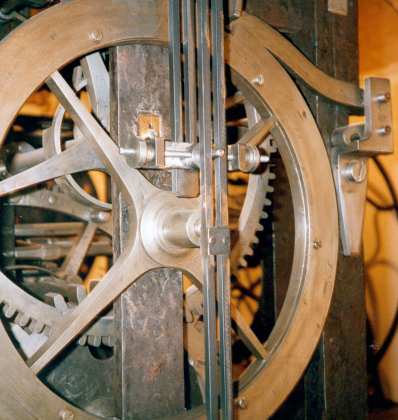
Detail of the beat regulation device on the new pendulum.
Escape Wheel
The modified beat rate of the new pendulum required the rebuilding of the escapement; the restorers replaced the existing anchor and pin-wheel with new ones. They retained the pinwheel, although they claimed to be returning the movement to the 1757 state. At that time, however, the escapement was a Graham dead-beat. Furthermore, they used stainless steel machine cap-head screws to form the pins.
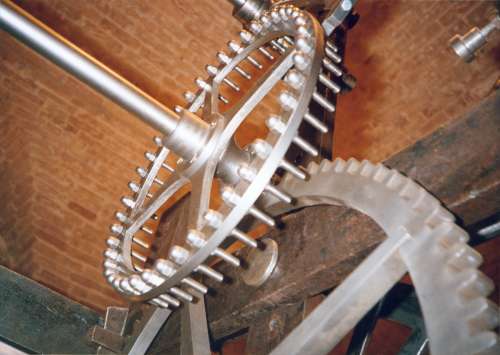
The new escape wheel, the pins turned from cap-head screws.
5-Minute Mechanism
Brusa and Gorla changed the way in which the 5-minute mechanism driving the digital display is actuated. In the 1858 movement, the escape arbor carried a small wheel, engaging with another wheel carrying a pin acting on a lever connected to the 5-minute train. Not an ideal solution, but it was never a source of problems for the proper running of the clock. In the restoration a completely new set of levers was made to actuate the mechanism from a lower wheel in the time train. Was this really necessary in a "conservative" restoration?
Astronomical mechanism
The 18th Century astronomical indication mechanism was modified to allow easy adjustments for the normal shift of the indications in respect to the real sun and moon positions. This could have been a good idea if it was not achieved by drilling the hub of the original Ferracina wheels. Brusa said that the 1757 work was excellent, but in this case he damaged it to achieve a result that was not required by the restoration. Everybody can accept the accumulation of errors in astronomical indications in an 18th Century mechanism. Once again, brand new galvanised bolts, with stamped heads, were used throughout.
Other changes
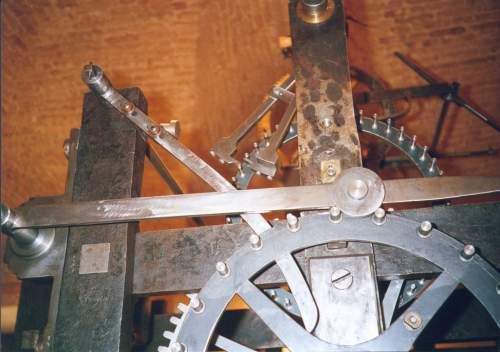
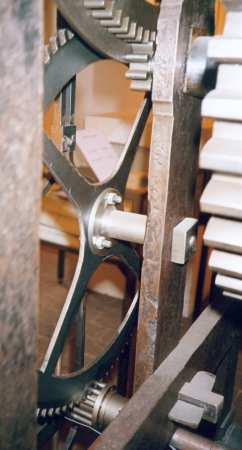
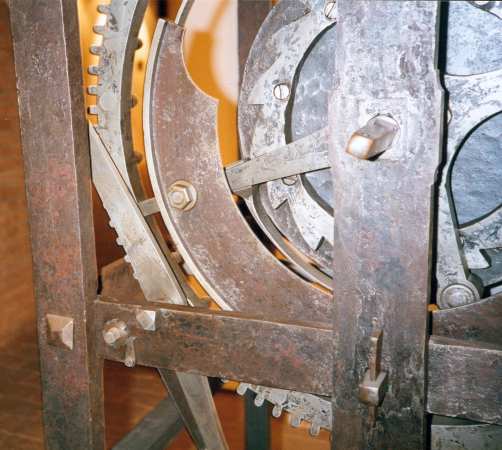
Was it too difficult or expensive to make them on a small lathe with the same proportions and materials used for the originals? Galvanized screws are simply ugly on a clock, not to speak of an 18th Century mechanism. We saw only a couple of screws that appeared to be made expressly for this clock: they were easily distinguishable from the old ones because the slots were not as neat as they should have been. They were clearly cut with a hacksaw, not with a cutter on the lathe.
All clock parts when dismantled were punched with a heavy hammer to identify them with figures. Was this really necessary? Why add other 20th Century marks to this mechanism? Some photos or sketches of the structure would have been equally effective.
Conclusion
We have to remember that Giuseppe Brusa and Alberto Gorla are very well known in Italy, respectively as the most eminent horological historian and as a tower clock specialist. Alberto Gorla has restored several important tower clocks all over the country. We had never seen any of his work before. We were astonished when we saw the result of his interventions on the St. Mark's clock for the first time. We could not imagine that a renowned clockmaker was capable of a failure like this. Since that time, we asked some of our colleagues if they had seen other examples of his work. We found two clockmakers who confirmed that he usually works this way. This is not a unique case.
It is not a pleasant situation to describe a fellow craftsman's work as wrong. Normally it should not be done. In this case it also casts doubt on the work of Italian clockmakers.
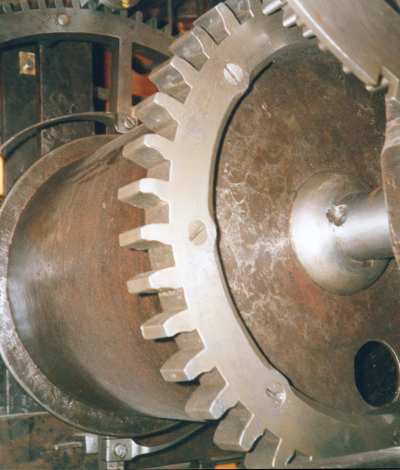
Unrestored winding wheel.